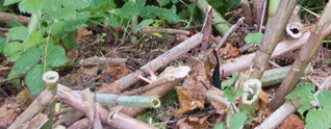If you read our blog "When is the Best Time to Treat Japanese Knotweed?" you'll know that the plant prepares to die back in the autumn months by moving all its nutrients down into its rhizomes. Introducing the herbicide at this critical point in the weed's lifecycle will help ensure it doesn't re-emerge again in Spring.
But what does Japanese knotweed look like in winter? Well, like most plants, when the temperature in your garden plummets, they die back for the winter. Plants with rhizome systems like Japanese knotweed will preserve their energy and survive under the soil until more favourable conditions return.

Japanese knotweed in winter becomes dry, brittle and brown. The stalks which were once red and purple and full of leaves have turned woody and bamboo-like. The canes are hollow and will collapse around each other as they die.
If the area hasn't been treated until this point, you can't guarantee that the knotweed won't come back stronger in a few months time. That's why swift Japanese knotweed treatment is always recommended.
Read more on Japanese Knotweed Identification
What should I do if I suspect I have a knotweed problem?
Whether you spot Japanese knotweed on your property is spring, summer or winter, it's vital that you get in touch with a professional removal company right away. You CANNOT rely on the winter months to take care of the knotweed problem for you.
We can survey your garden free of charge to find out if the plant you've spotted is actually Japanese knotweed. If it is, we'll be able to offer you a quotation for thorough removal, meaning the knotweed won't have a chance to spread around your property further.
Request a FREE Japanese Knotweed Survey
If you have any questions about identifying Japanese knotweed, or if you'd like to speak to our team about treatment, contact us today!
